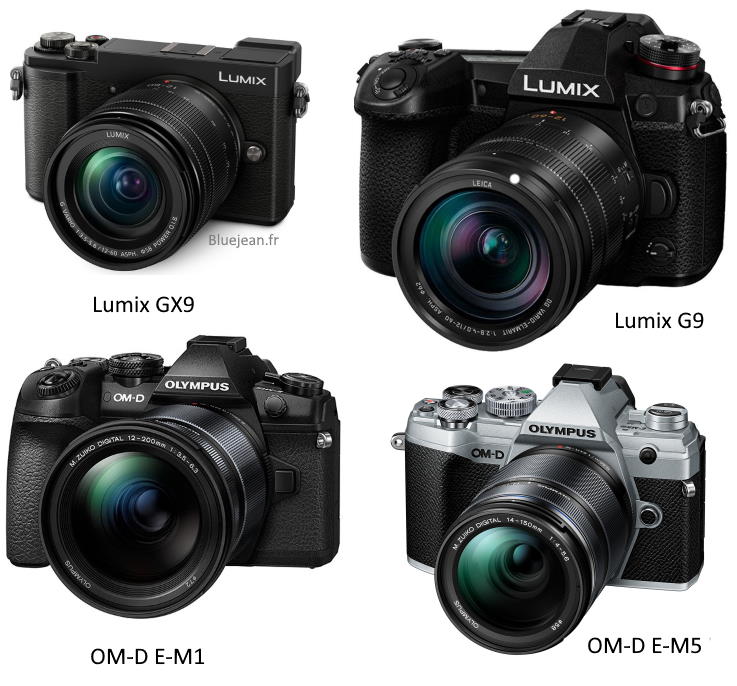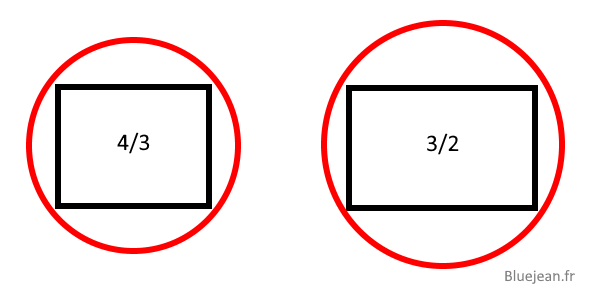The best Micro 4/3 camera in 2021
Ideal for video, action, nature, they have features not available on larger sensor cameras.

Why choose the Micro 4/3 format?
It is certain that a larger sensor, capturing more light, makes it possible to obtain better images. So why choose the 4/3 format which is 30% smaller than the APS-C?
The advantage of the big sensor appears especially when the brightness decreases, and that is when we must capture a maximum of light. It can be compensated by a lens with a larger aperture, however, to reach the level of light you want to receive.

The 4/3 ratio fits in a smaller circle: lens are narrower therefore less heavy
Micro 4/3 sensor cameras are particularly suitable for video, where the smaller sensor size allows for better stabilization while making also photos with a higher resolution than the 4K video format.
But manufacturers also take advantage of this smaller sensor to offer additional features like high-resolution mode or focus stacking that are not implemented on APS-C and rarely on full frame formats.
High resolution captures the same scene multiple times and combines the shots to get a much more accurate picture. It requires a tripod and no movement in the scene.
Focus stacking combines multiple images with different focus to create a single image that is sharp at all distances. May be made interactively or automatically depending on the model. Does not work with all lenses.
One can also have the pre-shot option (pre-burst for Panasonic): when one presses half the shutter, images are taken in bursts and the last ones are stored in memory. They are recorded on the SD card when the shutter is fully pressed. This is useful when you want to capture a sudden event, which could come too fast and be missed.
The other advantages of the M43 for photos is that the stabilization in the body allows a long exposure without tripod, as well as a higher shutter speed and burst speed. The price is not part of the benefits though! This is offset by that of the lenses which is often lower than that of other formats. And there are very good lenses in M43 in all focal lengths.
We realize the crippling that manufacturers like Canon and Sony inflict to the APS-C models when we go through the list of functions offered on M43...
Comparison of best Micro 4/3 cameras
| GX9 | G9 | E-M5 III | E-M1 III | |
|---|---|---|---|---|
| Resolution in 4:3 | 5184x3888 (20 MP) | 5184x3888 (20 MP) | 5184x3888 (20 MP) | 5184x3888 (20 MP) |
| Resolution in 3/2 | 5184x3456 (18 MP) | 5184x3456 (18 MP) | 5184x3456 (18 MP) | 5184x3456 (18 MP) |
| Resolution in 16:9 | 5184x2920 (15MP) | 5184x2920 (15 MP) | 5184x2920 (15 MP) | 5184x2920 (15 MP) |
| 6k burst mode | - | 5184x3456 (18 MP) | - | - |
| High resolution | - | 40 or 80 MP JPEG | 50 MP JPEG, 80 MP RAW | 80 MP JPEG/RAW 50 MP handheld |
| Digital zoom | Photo 2x, Video 4x | Photo 2x, Video 4x | Photo 2x, Video 3x | Tele converter 2x |
| Sensitivity | ISO 100-25600 extended | ISO 100 - 25600 extended | ISO 64-25600 extended | ISO 64-25600 |
| Autofocus | Contrast detection / face / eye / tracking / lock | Contrast detection / eye / tracking / lock | Phase and contrast detection / eye / tracking / lock / group | Phase and contrast detection / eye / tracking / lock |
| Autofocus zones | 49 | 225 | 121 | 121 |
| Shutter speed | 1/4000 mecanical - 30 mn 1/16000 electronic |
1/8000 mecanical - 30mn 1/32000 electronic |
1/8000 mecanical - 60s 1/32000 electronic |
1/8000 mecanical - 60 s 1/32000 electronic |
| Silent mode | yes | yes | yes | yes |
| Aperture bracketing | yes | yes | yes | yes |
| Focus bracketing | 999 images | 999 images | 999 images | 999 images |
| WB bracketing | yes | yes | yes | yes |
| AE bracketing | yes | yes | yes | yes |
| Post-focus | yes | yes | - | - |
| Focus stacking | yes | Auto-Merge | 3-15 images - Depends lens. | 3-15 images - Depends lens. |
| Panorama | yes | yes | - | - |
| HDR auto | yes | yes | 2 modes | 2 modes |
| Burst | 9 images/s or 30 in 4K | 12 images/s or 30 in 6K or 60 en 4K | 30 images/s silent | 60 images/s silent |
| Pre-shot / Pre-burst | - | 1 second before | 14 images | 35 images |
| IBIS | 5 axis | 5 axis | 6.5 stops | 7 stops |
| Format of still images | JPEG, RAW | JPEG, RAW | JPEG, RAW | JPEG, RAW |
| Time lapse | yes | yes | yes | - |
| Video | 4K 30 fps FHD 60 fps |
4K 60 fps FHD 150 fps |
4K 30 fps FHD 120 fps |
4K 30 fps FHD 120 fps |
| Video max duration | 90 mn | 65 mn | 60 mn | 60 mn |
| Microphone | Stereo + wind | Stereo + wind | Stereo | Stereo |
| Audio output | - | 3.5 jack | - | 3.5 jack |
| Video format | MPEG-4, AVCHD | MP4, AVCHD | MP4, AVCHD | MP4, AVCHD |
| Bluetooth | 4.2 | 4.2 | yes | 4.2 |
| Wi-Fi | yes | 5 GHz and 2.4 GHz | yes | yes |
| Integrated flash | yes | - | - | yes |
| Autonomy | 260 images | 400 images | 310 images | 420 images |
| Viewfinder | LCD 2760 MP 0.7x | OLED 3680 MP 0.83x | OLED 2.36 MP 0.68x | OLED 2.36 MP 0.74x |
| Touch screen | Focus and menus | Focus and menu | Focus and menu | Focus and menu |
| Screen orientation | Tilt | Articulated | Articulated | Articulated |
| Screen resolution | 1240 K | 1040 K | 1037 K | 1037 K |
| Slots | 1 SD | 2 SD | 1 UHS-II | 1 UHS-II + 1 UHS I |
| Weather sealing | - | yes | yes | yes |
| Interfaces | USB 2 Micro B, Micro HDMI | USB 3 Micro-B, HDMI A | USB 2, Micro HDMI | USB 3 Type C, HDMI D |
| Dimensions | 124 x 72,1 x 46,8 | 136,9 x 97,3 x 91,7 | 125 x 85 x 50 | 134,1 x 90,9 x 68,9 |
| Weight with battery | 450 g | 658 g | 414 g | 580 g |
| Year | 2018 | 2017 | 2019 | 2020 |
| Price body only | $600 | $900 | $900 | $1500 |
Which one to choose?
Lumix GX9
The most compact but not the lightest. It does not have all the features of others, it lacks high resolution, pre-shot, but is much cheaper.
Lumix G9
The most complete when for video. The auto-merge option automatically merges images with different focus. It's the heaviest of the four. The weight to carry also depends on the lens, but the short focal lengths most often used in video do not increase it much. Its viewfinder is the most comfortable.
Olympus E-M5 III
Five years after the E-M5 II, Olympus finally announces version 3 with the sensors and processors of the E-M1 II. It also borrows their enhanced autofocus on the E-M1 II and E-M1 X. Focus stacked pictures are produced automatically from up to 15 images.
Comparison between E-M5 III and E-M5 II:
- New sensor and new processor.
- 20 MP instead of 16 MP.
- High resolution of 80 MP against 40 MP.
- Autofocus with phase detection.
- Burst 30 fps against 10 fps.
- Speed 1/32000 against 1/16000.
- Improved stabilization.
- OLED viewfinder.
- Articulated screen.
- 4K video.
- Slow motion.
- Bluetooth.
- UHS-II vs UHS I.
- Charging via the USB port vs charger only.
- Lighter plastic case.
Olympus E-M1 III
Like the E-M5 III, has a better autofocus than the Lumix and pre-shot to not miss the action. Automatic focus stacking produce entirely focused images made by the camera itself. Has two SD card slots like the G9. The other advantages are the more modern connectors and better autonomy.
Unlike the G9, autofocus is fast in burst mode and video.
Compared to the Mark II, the newer Mark III version adds a live ND filter, 50 MP handeld high res shot, timelapse and bluetooth. The number of actuations is now 400000 rather then 200000.
Updated June 26, 2020:
The announcement by Olympus of the sale of its photo activity may raise doubts about the sustainability of its cameras. In the long run it is likely that getting repair service will be more difficult. But for the years to come, this should not change anything for owners of Olympus cameras and Zuiko lenses.
Updated November 9, 2020:
Replaced the Olympus E-M1 II by the E-M1 III.
See also :






